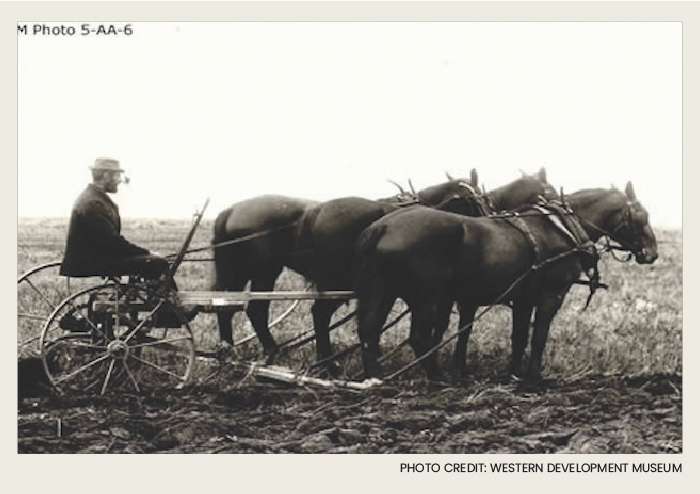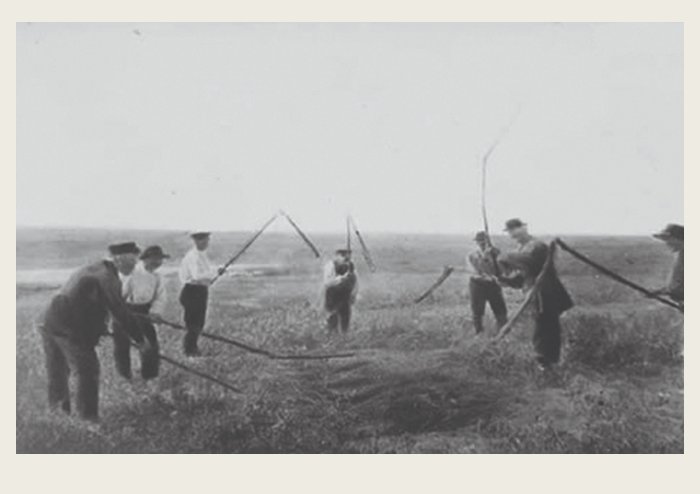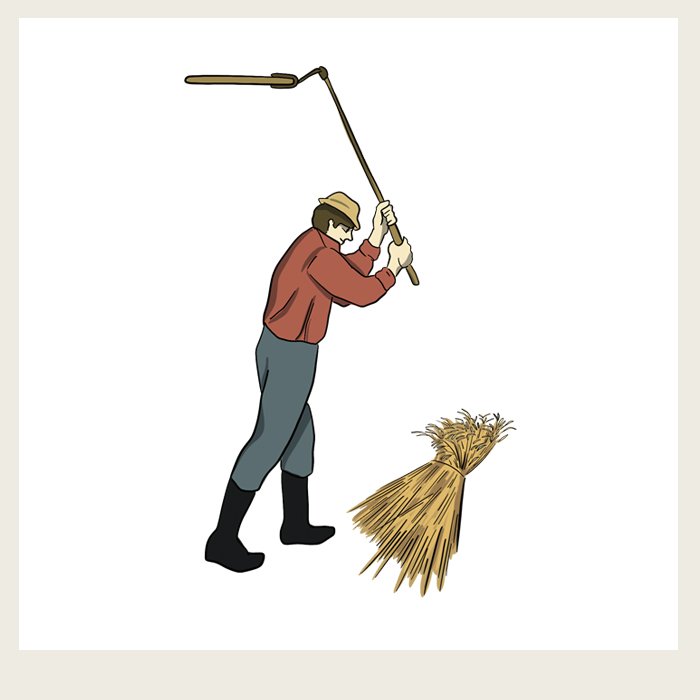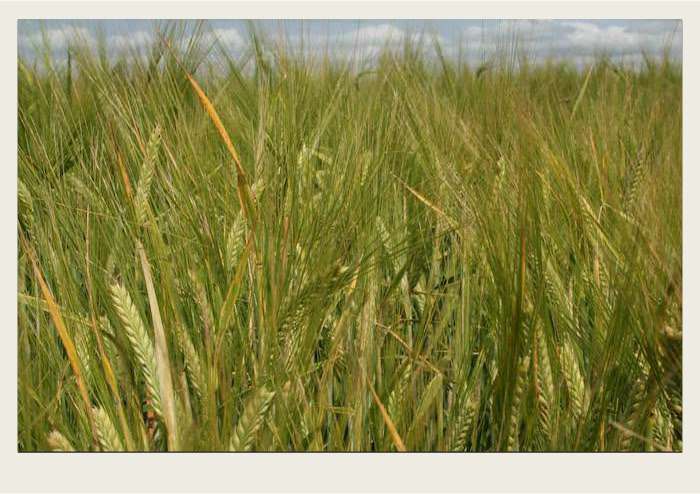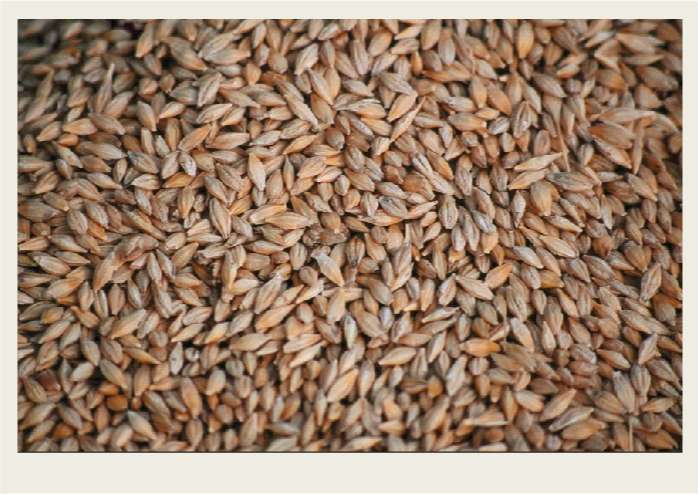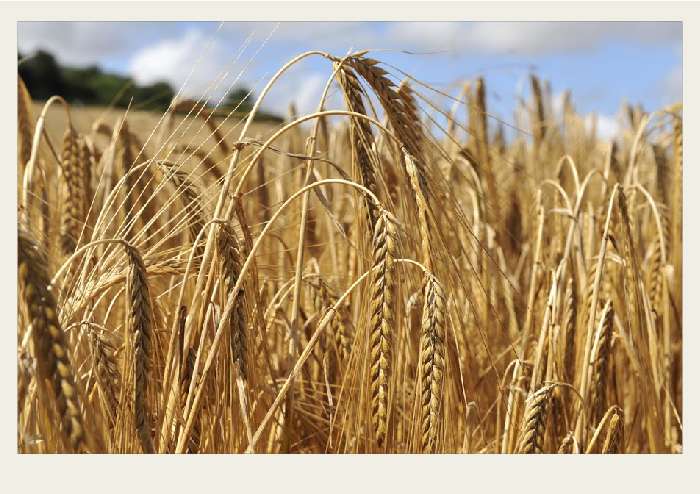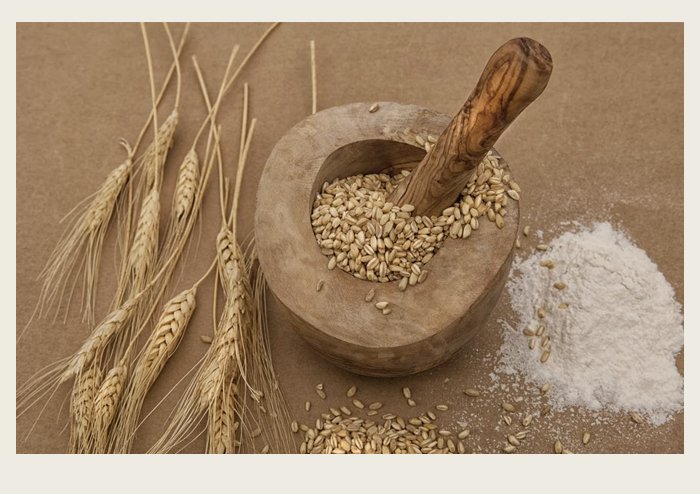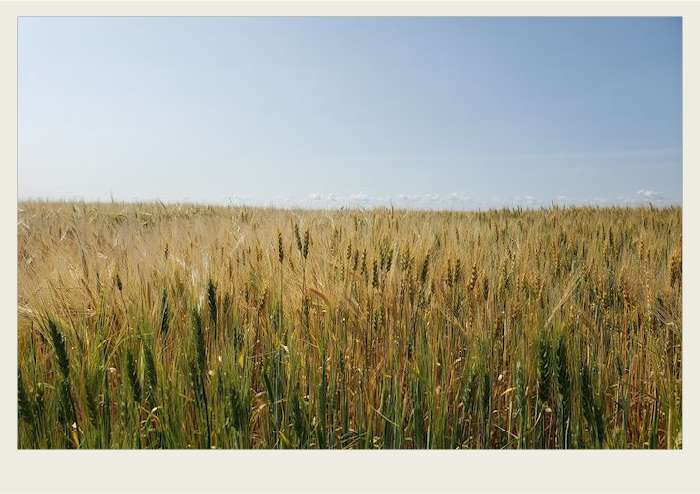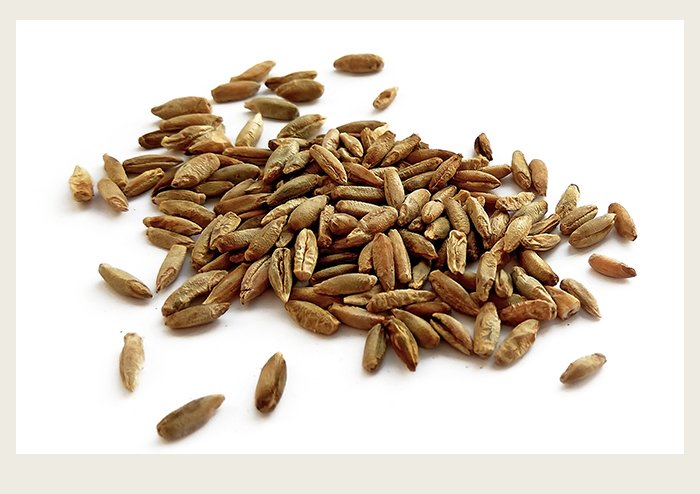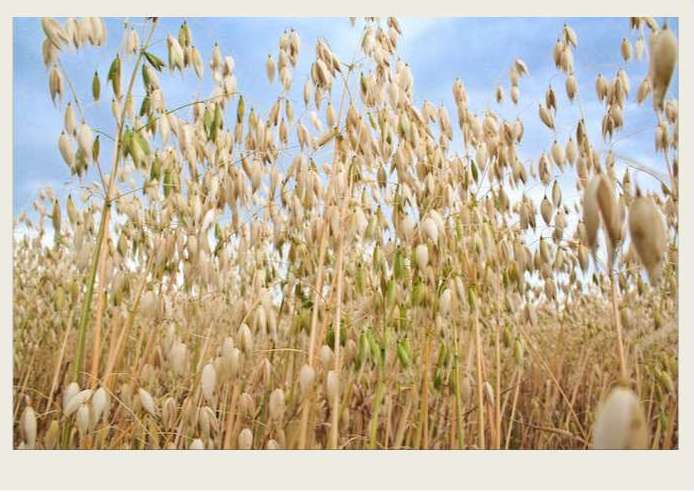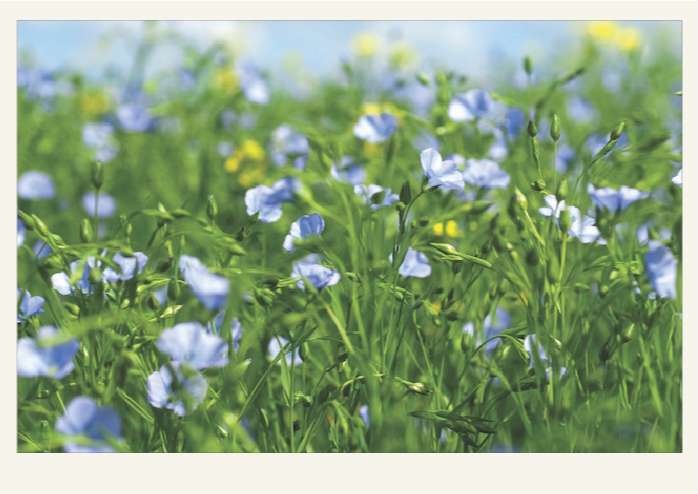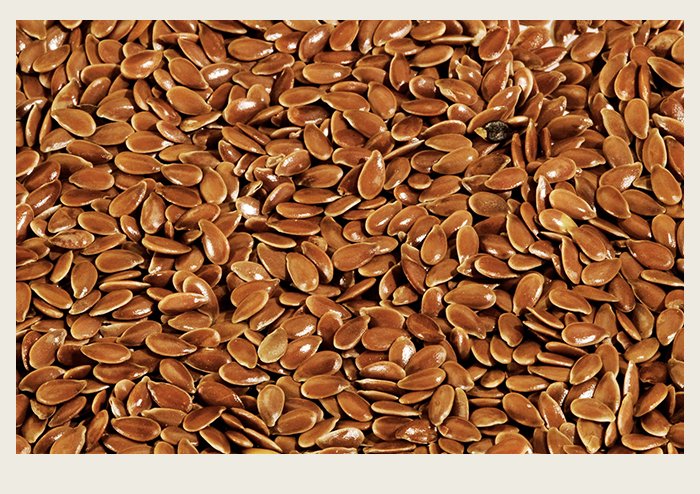Crops
Overview
Taking care of the land, planting and harvesting was hard, physical labour for farmers in the past. Farmers needed to use the resources available to them to help make their jobs easier. Farmers would use their animals and make or trade tools to help them with farming.

PHOTO CREDIT: WESTERN DEVELOPMENT MUSEUM
Farmers are using pitchforks to put grain into the threshing machine.
Planting
Before the farmer was able to start planting, the land had to be broken up with a plow. Soil can be hard and compact and plowing broke up the soil’s blocky texture. Plowing was important for several reasons because it would:- Cut down the weeds and old crop
- Bring fresh nutrients to the soil
- Make room for the plants’ roots to grow
- Improve the water drainage in the soil
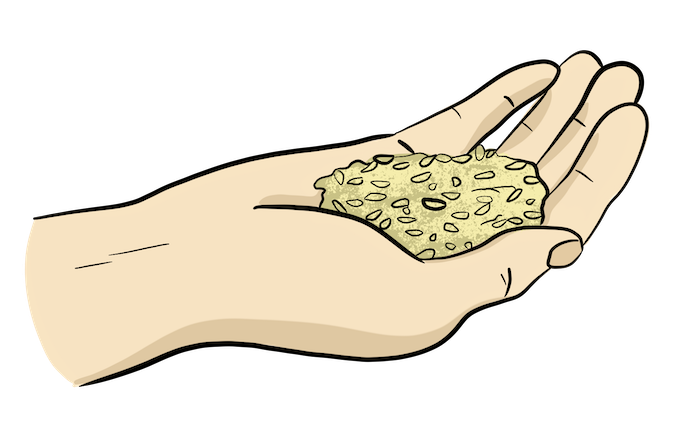
A handful of the wheat seed that will be seeded in the spring to grow a wheat crop.
The plow had a sharp blade that cut into the earth and turned over the soil. The plow was pulled by oxen or horses. The farmer kept the blade of the plow in the ground and had to be careful not to hit any large rocks, stumps or roots.
A harrow would be pulled over the soil to break up the lumps and smooth out the ground. A harrow looked like a large rake with rows of teeth.
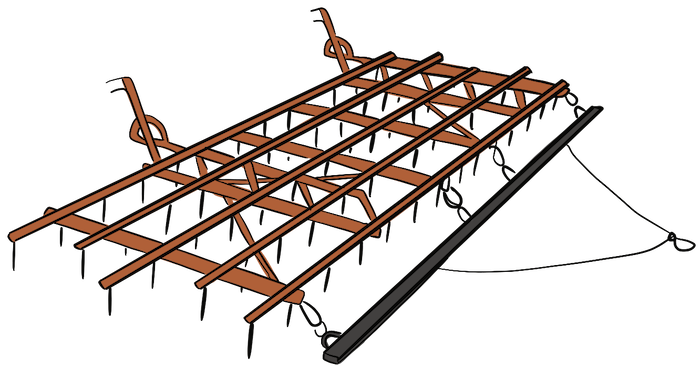
The harrow would be pulled by horses or oxen over the soil to break up the lumps and smooth out the ground.
Early drills were very small and could be pulled by one horse. The drill planted the seeds in rows, it would also push the soil to cover the seeds. When larger drills were made, a farmer would need more horses to pull the machinery.

PHOTO CREDIT: WESTERN DEVELOPMENT MUSEUM
These drills made seeding much less labour intensive, but were heavier to pull and required more horses to pull them.
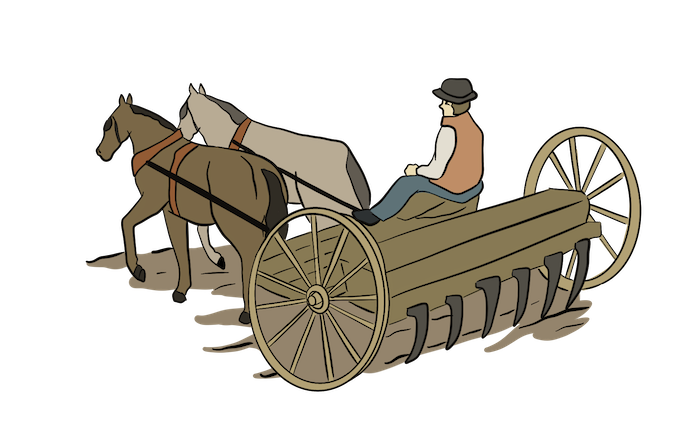
Farmers used seed drills to plant seeds into the ground.
Harvest
Harvesting a crop means cutting down the stalks and threshing the grain. Threshing the grain means removing the seed from the straw and husks.

PHOTO CREDIT: WESTERN DEVELOPMENT MUSEUM
This whole family is helping out to harvest their crop on their farm in 1938.
Harvest was a busy and important time on the farm. There was a lot of work to complete harvest each year before winter came. Families and neighbours often worked together to get everything done in time before the first frost.

PHOTO CREDIT: WESTERN DEVELOPMENT MUSEUM
A group of harvesters have cut the crops and bundled the stalks into these sheaves that were left to dry in the field before being hauled into the barn.
When a crop was ready to harvest, the farmer used a sickle, scythe or cradle scythe to cut the crop. Next, the stalks were bundled into sheaves. The bunch of sheaves were leaned against each other so the sheaves stood up. The standing bundles were called stooks. The stooks were left to dry in the field. Later, the sheaves were hauled to the barn.
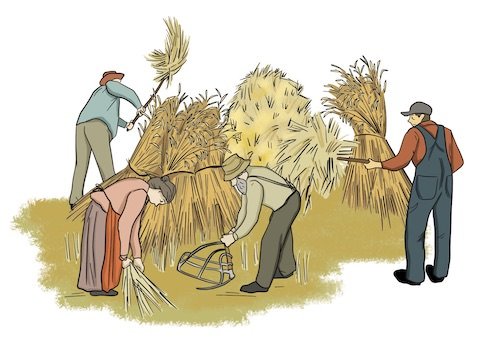
Farmers helping each other to get the crop off the field before the first frost.

PHOTO CREDIT: WESTERN DEVELOPMENT MUSEUM

PHOTO CREDIT: WESTERN DEVELOPMENT MUSEUM
Bunches of sheaves were piled into standing bundles called stooks.
The grain was spread out on the floor of the barn or outside on the ground and hit with a flail. Seeds, chaff (bits of seed head) and straw remained. The straw was used as bedding for the farm animals or as a mattress-filler.
A group of people are demonstrating how flails were used to remove seeds from the sheaves.
After the flail was used, the seeds often still had some of outer shell on them. It was important to separate the outer shell (called chaff) from the seed because only the seed was edible. The process of separating the seed from the chaff is called winnowing. This is a very old practice that has been used all over the world. The winnowed grain was stored for animal feed or taken in sacks to the mill to be ground into flour. This stone-ground flour was better than flour ground by hand.
This is an illustration of a farmer winnowing grain.
Threshing Crews
Eventually flailing and winnowing was replaced by threshing machines. Threshing machines were very expensive and most farmers couldn’t afford them so they hired threshing crews to help them harvest. Threshing crews traveled from farm to farm with huge machines that would thresh the grain. It took a crew of 10-12 men an average of one week to thresh the average farm. Many men from the United States and Eastern Canada were on threshing crews.
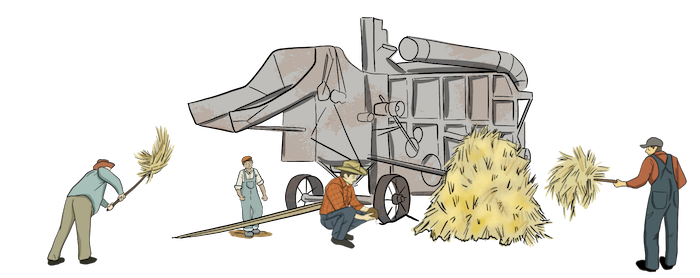
The threshing crews would go from farm to farm sharing the work and the machinery.
The threshing crews would work long, hard days in the summer heat to harvest crops. Everyone in the farming families would help out by hauling the stooks on hay carts to the threshing machine in the field to separate the grain from the straw. Kids would have jobs such as hauling water for the men to drink and to wash up with. Neighbouring women would team up to provide meals to all of the families and to the threshing crew.

PHOTO CREDIT: WESTERN DEVELOPMENT MUSEUM
Threshing machines were often used by crews of men at harvest to eliminate threshing the crop by hand. This threshing crew is seen in action in September 1947.
Types of Crops
Many of the farmers brought seeds from their homeland and planted those seeds for their first crops. The crops that were planted were wheat, rye, oats, barley, and flax. The climate was different in the Prairies though and the crops did not always grow well or sometimes they froze because of the short summers.
Farmers used their crops to provide food for their families and their animals. Farmers also always saved some seed to plant the following year. Extra seed was traded or sold to get other items they needed that they could not make themselves, such as salt, sugar, cooking equipment, etc.
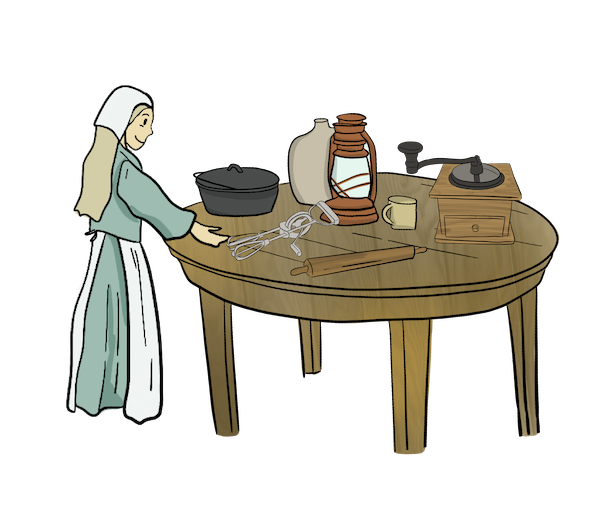
Farmers sold extra seeds so they could buy items they needed, such as household items.
Barley
Barley was used to feed the farm animals. Many of the settlers’ breads, soups, and stews also had barley in them.Wheat
Wheat was used to make flour, which could be used to make loaves of bread, pastries, and pasta.
Rye
Rye could be used to make flour as well, but sometimes rye crops grew better in certain types of soils than wheat crops did. Rye straw was also incredibly strong and could be used for a variety of things, such as basket making, insulation, and padding for horse equipment.
Oats
Oats were mainly used to feed the horses. Settlers would also make a breakfast porridge using oats.
Flax
Flax was used for making linen because the flax fibres were very strong, absorbent, and dried faster than cotton. Also farmers in Saskatchewan could not grow cotton because of the weather.

